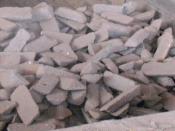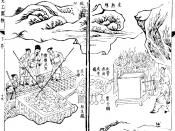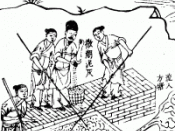The element iron gets its name from the Anglo-Saxon word "iron". It's symbol, Fe, comes from the Latin word "ferrum", which means "iron". The word "iron"ÃÂ itself, may come from early words that meant "holy metal", because it was used to make swords during the Crusades.
Iron is an extremely important element, and it has been throughout history. Some iron artifacts have been identified to be from around 3000 B.C. The book of Genesis says that Tubal-Cain, a man seven generations away from Adam, was an "instructor of every artificer in brass and iron". And during the Iron Age, iron was used for making weapons, as well as decorations. Today, iron is the major ingredient in electromagnets and in galvanized sheet metal. It is also used in tonics, a is used to treat anemia.
Iron nuclei are very stable, and iron is found in abundance throughout the universe. There is iron in the sun and also in many types of stars.
It is a vital part of plant and animal life, and is also the key component of hemoglobin in red blood cells.
Iron is a soft, pliant, and flexible metal. It is silvery and shiny, and has magnetic properties until heated to 790ÃÂðC. The atomic number of iron is 26, and its atomic mass is 55.845u. Its melting point is 1811 K, and its boiling point is 3134 K. The density of iron is 7874 kg m-3. Its oxidation states are +2 and +3.
In the presence of water, iron combines with oxygen to form rust. The pure metal iron is very chemically reactive, but it does not react to acid and other substances when dipped into a concentrated nitric acid. This is because a layer of oxide is formed. The pure metal is usually alloyed with carbon or...


